
PHOTO PAGE

To view full size photos click on thumbnails below. If thumbnails don't
appear
right click image placeholder where "x" appears and select
Show Picture in the popup menu.
|
 Lance Cove
1927 - The
original Rees homestead has been dismantled. Jimmy Gus has moved
his forge to the beach property. St. Mary's bell tower,
dedicated by bishop Jones, August 19, 1919, overturned, Septempter 25, 1916, in a terrific southerly
gale that resulted in the bell and its associated
parts being broken, has been restored. Lance Cove
1927 - The
original Rees homestead has been dismantled. Jimmy Gus has moved
his forge to the beach property. St. Mary's bell tower,
dedicated by bishop Jones, August 19, 1919, overturned, Septempter 25, 1916, in a terrific southerly
gale that resulted in the bell and its associated
parts being broken, has been restored. |
|
 The
Bell - The Bell, from which the island derives its name.
Also shown are the Front Bell Cove and the vertical rock known as
Cole-east. The
Bell - The Bell, from which the island derives its name.
Also shown are the Front Bell Cove and the vertical rock known as
Cole-east.
|
|
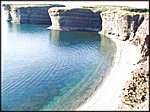 The
Front Bell Cove - Front Bell Cove with its fine sandy beach
was a great place for capelin, and during the capelin scull it
was a common sight to see Lance Cove boats returning from there
laden to the gunwales. The
Front Bell Cove - Front Bell Cove with its fine sandy beach
was a great place for capelin, and during the capelin scull it
was a common sight to see Lance Cove boats returning from there
laden to the gunwales.
|
|
 The
Clapper - A familiar Lance Cove landmark, located
equidistant between there and the Bell. Considering that proximity
and its shape, the origin of its name is obvious. Directly off the
Clapper was the best jigging ground, and it was there that uncle
Alfred caught in one summer, single-handed, 160 quintals, besides
managing his farm and dairy herd. The
Clapper - A familiar Lance Cove landmark, located
equidistant between there and the Bell. Considering that proximity
and its shape, the origin of its name is obvious. Directly off the
Clapper was the best jigging ground, and it was there that uncle
Alfred caught in one summer, single-handed, 160 quintals, besides
managing his farm and dairy herd. |
|
 Kerry
Head - Kerry head, named for
County Kerry, Ireland, place of origin of the Kennedy clan. It was in this area of Lance Cove that the Kennedys settled
and where their meadows were. Kerry
Head - Kerry head, named for
County Kerry, Ireland, place of origin of the Kennedy clan. It was in this area of Lance Cove that the Kennedys settled
and where their meadows were.
|
|
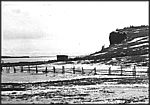 Skating
Place - Another view of Kerry Head, overlooking Sandy
Bennett's marsh. Wintertime when the droke brook overflowed
its meandering course to the gut, the result was the gathering
spots for skating and for hockey. The brook now flows
directly into the newly dredged boat pool.
Skating
Place - Another view of Kerry Head, overlooking Sandy
Bennett's marsh. Wintertime when the droke brook overflowed
its meandering course to the gut, the result was the gathering
spots for skating and for hockey. The brook now flows
directly into the newly dredged boat pool.
|
|
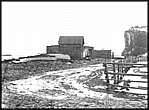 The Beach
- The
beach c. 1953. Sad
remains of what was once a thriving fishing premises.
Site of present day boat pool. The Beach
- The
beach c. 1953. Sad
remains of what was once a thriving fishing premises.
Site of present day boat pool.
|
|
 The
View From the Wharf - This view from the
wharf, 1954, shows Pitts's hill after it ceased to be part of the main road between Lance Cove and the east end of the island.
Sometime around 1944 a road was built from Mick Tom Hammond's straight
across to where the Bickford's lived; thus bypassing the old beach road
through the cove. The
View From the Wharf - This view from the
wharf, 1954, shows Pitts's hill after it ceased to be part of the main road between Lance Cove and the east end of the island.
Sometime around 1944 a road was built from Mick Tom Hammond's straight
across to where the Bickford's lived; thus bypassing the old beach road
through the cove.
|
|
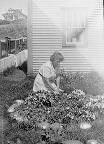 Mary
Rees - My mom, Mary, tending her little flower garden 'neath
the south-facing kitchen window of the old house on Lance Cove
beach. The encroaching sea has since reclaimed this space, as it
has much of the waterfront land where once was located, not
only fishing premises, but even vegetable gardens. Mary
Rees - My mom, Mary, tending her little flower garden 'neath
the south-facing kitchen window of the old house on Lance Cove
beach. The encroaching sea has since reclaimed this space, as it
has much of the waterfront land where once was located, not
only fishing premises, but even vegetable gardens. |
|
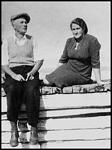 Jim
and Mary, 1947 - Dad
and mom enjoying the respite of a sunny Sunday afternoon.
The wharf was a gathering place on Sundays and summer evenings
where grownups strolled or stood around to chat and watch the
children at play. Jim
and Mary, 1947 - Dad
and mom enjoying the respite of a sunny Sunday afternoon.
The wharf was a gathering place on Sundays and summer evenings
where grownups strolled or stood around to chat and watch the
children at play.
|
|
 Old Lance Cove photo, late
1800s - Taken while the Pitts homestead was still Old Lance Cove photo, late
1800s - Taken while the Pitts homestead was still
being occupied by "aunt" Fanny. House to the left was that of George Rees,
1855-1920. In the background is "uncle" Mike Hammond's house.
|
|
 James
Pitts' House - The remains of the home
of James Pitts, first permanent house to be built in Lance Cove.
In the background can be seen the homes of uncle Jimmy and uncle
Mike Hammond. James
Pitts' House - The remains of the home
of James Pitts, first permanent house to be built in Lance Cove.
In the background can be seen the homes of uncle Jimmy and uncle
Mike Hammond.
|
|
 James
Jr. Pitts' House
- Home of James Pitts Junior,
situated just across the road from his father's place.
This house remained in use until 1929 when Ralph Rees moved
to the new house that he built on the beach and which is still
standing there, beautifully maintained. James
Jr. Pitts' House
- Home of James Pitts Junior,
situated just across the road from his father's place.
This house remained in use until 1929 when Ralph Rees moved
to the new house that he built on the beach and which is still
standing there, beautifully maintained.
|
|
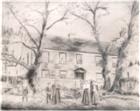 James
Jr. Pitts' House -
The home of James Pitts Jr. This
house was purchased by George Rees Jr. sometime after 1825 and
occupied by that branch of the Rees family until 1929 when Ralph
and Emma Ann, the last occupants, moved to their new house, on the
same property but nearer the seashore. The photo was taken c.
1890-95 while the house was being occupied by William and Louisa
and their family of eight children. James
Jr. Pitts' House -
The home of James Pitts Jr. This
house was purchased by George Rees Jr. sometime after 1825 and
occupied by that branch of the Rees family until 1929 when Ralph
and Emma Ann, the last occupants, moved to their new house, on the
same property but nearer the seashore. The photo was taken c.
1890-95 while the house was being occupied by William and Louisa
and their family of eight children. |
|
 Powder
Horn - This beautiful old powder horn was carved by John Stone and dated by him, Feb. 3rd., 1824. Mr. Stone married Elizabeth (Betsy), daughter of William Pitts, son of pioneer James. The carving is a wonderful example of early Newfoundland folk art. Besides the ship and lettering, there are several allegorical vignettes. The initials W.R. carved in the neck of the horn is an indication that at some point it came in the possession of one of the Lance Cove Reeses where it presently belongs. Powder
Horn - This beautiful old powder horn was carved by John Stone and dated by him, Feb. 3rd., 1824. Mr. Stone married Elizabeth (Betsy), daughter of William Pitts, son of pioneer James. The carving is a wonderful example of early Newfoundland folk art. Besides the ship and lettering, there are several allegorical vignettes. The initials W.R. carved in the neck of the horn is an indication that at some point it came in the possession of one of the Lance Cove Reeses where it presently belongs.
|
|
 Pitts's
Hill - Pitts's
Hill, gathering place for winter sliding. On moonlight nights when
the older ones came out to play and there were lots of bobsled
spills, the air was filled
with squeals of delight and frolicking laughter. Those were
carefree times. Ralph and old Barney are seen in the photo
returning from "in over the hill" with a load of
firewood. Pitts's
Hill - Pitts's
Hill, gathering place for winter sliding. On moonlight nights when
the older ones came out to play and there were lots of bobsled
spills, the air was filled
with squeals of delight and frolicking laughter. Those were
carefree times. Ralph and old Barney are seen in the photo
returning from "in over the hill" with a load of
firewood.
|
|
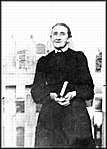 Fanny
Pitts - Frances Louisa Pitts
(Fanny) 1832 - 1913. Granddaughter
of pioneer James, and the last of her family to live in Lance
Cove. Fanny
Pitts - Frances Louisa Pitts
(Fanny) 1832 - 1913. Granddaughter
of pioneer James, and the last of her family to live in Lance
Cove.
|
|
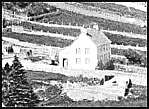 George
Rees's House - This old homestead, home of George and Mary Ann, first Rees house in Lance Cove, remained occupied until c. 1925. George
Rees's House - This old homestead, home of George and Mary Ann, first Rees house in Lance Cove, remained occupied until c. 1925. |
|
 Old Schoolhouse
- The old schoolhouse
surrounded by a clutch of Rees houses. The house, centre, with the gable roof and four upstairs
windows belonged originally to John Pitts but, subsequent to Mr.
Pitts early decease in 1825, it
was acquired by Reuben Rees. Other houses in view are those of
Thomas and Sarah, Thomas and Susannah, Edward (uncle Ned and aunt
Ann), William Thomas and Drusilla (grandparents)and Stephen and aunt Pricilla. Old Schoolhouse
- The old schoolhouse
surrounded by a clutch of Rees houses. The house, centre, with the gable roof and four upstairs
windows belonged originally to John Pitts but, subsequent to Mr.
Pitts early decease in 1825, it
was acquired by Reuben Rees. Other houses in view are those of
Thomas and Sarah, Thomas and Susannah, Edward (uncle Ned and aunt
Ann), William Thomas and Drusilla (grandparents)and Stephen and aunt Pricilla. |
|
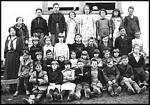 Class
of 1935-36
- Back row: Lillie Matthews (teacher), Mable Clements (lost
in Garland disaster, 1940), Doug Hussey, Walter, Debbie Pitts,
Violet Bickford, Sophie, Jane, Reid Wharford. Third row: Vera,
Irene, Myrtle, John, Lloyd, Frank, Eldred Bickford, Ches
Bickford. Second row: Dan Churchill, Bob, Charlie, Don,
Phyllis, Ethel May, Jean, Emma Clements, Rhoda Clements, Lilla.
Front row: Fred Churchill, Thelma, Lillian, Bill (of Eugene),
Stirling, Hubert Clememts, Bill (of Ned) Class
of 1935-36
- Back row: Lillie Matthews (teacher), Mable Clements (lost
in Garland disaster, 1940), Doug Hussey, Walter, Debbie Pitts,
Violet Bickford, Sophie, Jane, Reid Wharford. Third row: Vera,
Irene, Myrtle, John, Lloyd, Frank, Eldred Bickford, Ches
Bickford. Second row: Dan Churchill, Bob, Charlie, Don,
Phyllis, Ethel May, Jean, Emma Clements, Rhoda Clements, Lilla.
Front row: Fred Churchill, Thelma, Lillian, Bill (of Eugene),
Stirling, Hubert Clememts, Bill (of Ned)
|
|
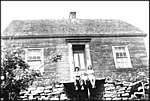 The
Old
House - The remains (1942) of the home of
William Thomas Rees (1843-1900), and Drusilla nee Hibbs
(1846-1932). This
house, built entirely of hand-sawn timber cut in his own woodlot,
was typical of many of the old houses in Lance Cove. The
Old
House - The remains (1942) of the home of
William Thomas Rees (1843-1900), and Drusilla nee Hibbs
(1846-1932). This
house, built entirely of hand-sawn timber cut in his own woodlot,
was typical of many of the old houses in Lance Cove.
|
|
 William
Thomas Rees - William Thomas Rees, 1843-1900. Father of Jimmy Gus. William
Thomas Rees - William Thomas Rees, 1843-1900. Father of Jimmy Gus.
|
|
 Drusilla
Rees - Drusilla nee Hibbs, 1846-1932. Wife of William
Thomas Rees. Drusilla
Rees - Drusilla nee Hibbs, 1846-1932. Wife of William
Thomas Rees.
|
|
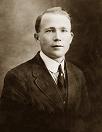 James
Augustus Rees
- 1890-1954, youngest of the eleven
children of William Thomas and Drusilla. James
Augustus Rees
- 1890-1954, youngest of the eleven
children of William Thomas and Drusilla. |
|
 Gertrude
Marion Rees - (Mrs. Ananias)
1885-1972. Aunt Gertie, sister of Jimmy Gus, paying a visit
to her aunt Caroline and uncle John Lee. Gertrude
Marion Rees - (Mrs. Ananias)
1885-1972. Aunt Gertie, sister of Jimmy Gus, paying a visit
to her aunt Caroline and uncle John Lee.
|
|
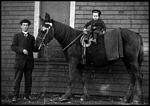 Fun
Time - Uncle Ed and little
nephew, Gerald. Edmund Francis, 1875-1941, is the bachelor brother
of Jimmy Gus. Gerald, 1912-1992, is a son of sister Gertrude and
Ananias. Fun
Time - Uncle Ed and little
nephew, Gerald. Edmund Francis, 1875-1941, is the bachelor brother
of Jimmy Gus. Gerald, 1912-1992, is a son of sister Gertrude and
Ananias.
|
|
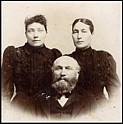 Reuben
Rees - brother of William Thomas, and sisters, Caroline Rees Lee
(left) and Jane Rees Drover. Uncle and aunts of Jimmy Gus. Reuben
Rees - brother of William Thomas, and sisters, Caroline Rees Lee
(left) and Jane Rees Drover. Uncle and aunts of Jimmy Gus.
|
|
 Martha Bickford
nee Rees - (Oct 1840 - 21 Feb 1929). Grand Daughter of George Rees ( 1772 - 1859) and Mary Ann Neary (1787 - 1874). Martha married Edward Bickford (1830 - 1885) son of Henry Bickford and Amy Cooper. Edward taught school in Lance Cove from c. 1857 - 1870 preceding the memorable school master, James Hiscock, who taught in Lance Cove from 1870 - 1912. Edward and Martha left Lance Cove c. 1870 and relocated to New Perlican, Trinity Bay, where Edward once again took a position as school master in that community. Following Edward's death in 1885, Martha returned to Lance Cove with their five children (William, Henry T, Reuben, Edward and Emma) and eventually re-married a Mr. Butt. Once again widowed when Mr. Butt passed away, she lived her remaining years with her son William. Her remains are buried in the old Anglican cemetery in Lance Cove. Martha Bickford
nee Rees - (Oct 1840 - 21 Feb 1929). Grand Daughter of George Rees ( 1772 - 1859) and Mary Ann Neary (1787 - 1874). Martha married Edward Bickford (1830 - 1885) son of Henry Bickford and Amy Cooper. Edward taught school in Lance Cove from c. 1857 - 1870 preceding the memorable school master, James Hiscock, who taught in Lance Cove from 1870 - 1912. Edward and Martha left Lance Cove c. 1870 and relocated to New Perlican, Trinity Bay, where Edward once again took a position as school master in that community. Following Edward's death in 1885, Martha returned to Lance Cove with their five children (William, Henry T, Reuben, Edward and Emma) and eventually re-married a Mr. Butt. Once again widowed when Mr. Butt passed away, she lived her remaining years with her son William. Her remains are buried in the old Anglican cemetery in Lance Cove.
|
|
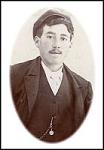 William
Bickford - (1879-1940) One of the sons to Edward and
Martha, and godfather of the author. William
Bickford - (1879-1940) One of the sons to Edward and
Martha, and godfather of the author.
|
|
 The Lee Premises
- John Lee married Caroline (aunt Carrie), daughter of William and Jane
Sophia (nee Hiscock) Rees. He built his house, a combined dwelling and general
store, on the beach property adjacent to the wharf. Jimmy
Gus, a nephew of Caroline and John, purchased this property, June
11, 1925 for the sum of $850 and it was there on November 20, 1926
that he moved his blacksmith shop. His first blacksmith shop
was built on his parents' property and opened for business
September, 1913. It was in this newly acquired home that I
was born, December 1927. The Lees moved to the east end of
the island. The Lee Premises
- John Lee married Caroline (aunt Carrie), daughter of William and Jane
Sophia (nee Hiscock) Rees. He built his house, a combined dwelling and general
store, on the beach property adjacent to the wharf. Jimmy
Gus, a nephew of Caroline and John, purchased this property, June
11, 1925 for the sum of $850 and it was there on November 20, 1926
that he moved his blacksmith shop. His first blacksmith shop
was built on his parents' property and opened for business
September, 1913. It was in this newly acquired home that I
was born, December 1927. The Lees moved to the east end of
the island.
|
|
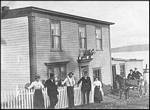 Another
View - The house where my
siblings and I were born and raised. The beach property on which
this house was located was purchased, 1901, by John Lee from the
estate of the late Cpt. William Pitts for the sum of one hundred
dollars. Another
View - The house where my
siblings and I were born and raised. The beach property on which
this house was located was purchased, 1901, by John Lee from the
estate of the late Cpt. William Pitts for the sum of one hundred
dollars.
|
|
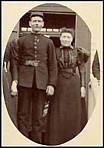 Lance Cove
Policeman - John Lee, and his wife, Caroline Rees Lee. c. 1900 Lance Cove
Policeman - John Lee, and his wife, Caroline Rees Lee. c. 1900
|
|
 Old
House - Home of my maternal grandparents, Stephen and Mary Jane
(Parsons). This house is an early 20th century enlargement
and redesign of the older homestead. It is one of the
oldest, if not the oldest house remaining in Lance Cove. It
presently belongs to a great granddaughter, Sherry Rees Rodgers. Old
House - Home of my maternal grandparents, Stephen and Mary Jane
(Parsons). This house is an early 20th century enlargement
and redesign of the older homestead. It is one of the
oldest, if not the oldest house remaining in Lance Cove. It
presently belongs to a great granddaughter, Sherry Rees Rodgers.
|
|
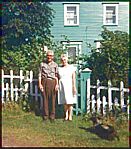 Stephen
and Gertrude Rees - Uncle
Stephe (April
4, 1908 - Sept. 8, 1997) and aunt Gertie, nee Babb (July19, 1908 - Feb. 23,1995) were the last surviving of my parental
relatives and the last Reeses of that generation to reside in Lance Cove. Stephen
and Gertrude Rees - Uncle
Stephe (April
4, 1908 - Sept. 8, 1997) and aunt Gertie, nee Babb (July19, 1908 - Feb. 23,1995) were the last surviving of my parental
relatives and the last Reeses of that generation to reside in Lance Cove.
|
|
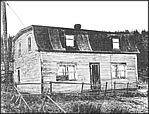 Terrence
Kennedy Homestead - This once beautiful old house was built
by Terrence Kennedy, 1876-1953, and where he and his wife Amelia
(Kent), 1878-1919, lived out the remainder of their days.
The house continued to be occupied by his son, Terry Jr. and his
wife, Nell, until the closing of the mines in 1966 when the family
moved away. Picture submitted by granddaughter Amelia
Fifield. Terrence
Kennedy Homestead - This once beautiful old house was built
by Terrence Kennedy, 1876-1953, and where he and his wife Amelia
(Kent), 1878-1919, lived out the remainder of their days.
The house continued to be occupied by his son, Terry Jr. and his
wife, Nell, until the closing of the mines in 1966 when the family
moved away. Picture submitted by granddaughter Amelia
Fifield.
|
|
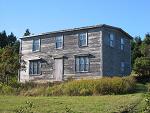 Hammond
Homestead
- An old Hammond
homestead. The design of this house is typical of the houses
built by the second generation of Lance Cove settlers. All the
original houses were gable roofed. Hammond
Homestead
- An old Hammond
homestead. The design of this house is typical of the houses
built by the second generation of Lance Cove settlers. All the
original houses were gable roofed. |
|
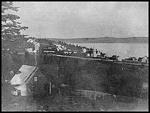 A
Parsons Homestead - This
old house was located on the site where the house of Richard
Parsons (uncle Dickie) stood in later years. It was the only
Parsons house in Lance Cove. According to a notation on the back
of the photograph, this was the home of Joseph Parsons, and is
where Joe, Jim and Eldred were raised. A
Parsons Homestead - This
old house was located on the site where the house of Richard
Parsons (uncle Dickie) stood in later years. It was the only
Parsons house in Lance Cove. According to a notation on the back
of the photograph, this was the home of Joseph Parsons, and is
where Joe, Jim and Eldred were raised.
|
|
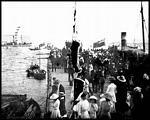 Lance
Cove Regatta - An annual event in
Lance Cove around the turn of the century and into the early
1900s. Shells (racing boats) were borrowed from St. John's but
some were built by the locals. One such boat which he named,
Blanche, after his daughter, was built by Tom Rees. Alf Rees, now
102 and still hale and hardy (2002), watched that boat race. Tom
is a frequently occurring name in the Rees clan. This particular
Tom, wife Elizabeth Waterman (1865-1938) of Fogo, was the son of
Solomon and Belinda Hiscock, 1833-1905. Tom and Elizabeth lost
three sons, Eldred, Dorman and Edgar, in the "Great
War", 1914-1918. Lance
Cove Regatta - An annual event in
Lance Cove around the turn of the century and into the early
1900s. Shells (racing boats) were borrowed from St. John's but
some were built by the locals. One such boat which he named,
Blanche, after his daughter, was built by Tom Rees. Alf Rees, now
102 and still hale and hardy (2002), watched that boat race. Tom
is a frequently occurring name in the Rees clan. This particular
Tom, wife Elizabeth Waterman (1865-1938) of Fogo, was the son of
Solomon and Belinda Hiscock, 1833-1905. Tom and Elizabeth lost
three sons, Eldred, Dorman and Edgar, in the "Great
War", 1914-1918.
|
|
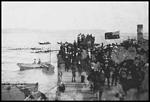 "Them
Were The Days" - Another view
of the Regatta. "Them
Were The Days" - Another view
of the Regatta.
|
|
 Little Bell Island
- Little Bell Island was very much a part of the life of Lance
Cove. For the younger lads who often rowed out to there on
summer days it was a wonderful place to explore. Dicky
Kent's motor boat, ever ready on the collars, was often engaged to
ferry groups of grownups and children to Little Bell Island on
summer Sunday afternoon excursions, or for blueberry
picking. According to F. F. Jardine, a planter by the name
of Bentley had a large fishing station there c. 1790, and with his
square-rigger supplied provisions to other stations around the
bay. John Skane from Dorset came to work at the staion but
when Bentley returned to England there was no further settlement
on Little Bell Island. Little Bell Island
- Little Bell Island was very much a part of the life of Lance
Cove. For the younger lads who often rowed out to there on
summer days it was a wonderful place to explore. Dicky
Kent's motor boat, ever ready on the collars, was often engaged to
ferry groups of grownups and children to Little Bell Island on
summer Sunday afternoon excursions, or for blueberry
picking. According to F. F. Jardine, a planter by the name
of Bentley had a large fishing station there c. 1790, and with his
square-rigger supplied provisions to other stations around the
bay. John Skane from Dorset came to work at the staion but
when Bentley returned to England there was no further settlement
on Little Bell Island.
The following account of the
defense of Little Belle Isle, 1696-97, is from D. W. Prowse's, A History of Newfoundland, p. 222: The first resident on this small island in Conception Bay was John
Earle, a West Countryman. He was a very smart, well educated young man; just of age in 1698, when he married in Harbour Grace Fanny Garland, sister of the well-known Justice
Garland. .........The French attacked Little Belle Isle with two barges full of soldiers. John Earle had cannon upon the cliff; he sank one barge with
a shot and the other then rowed off; he had scarecrows dressed up as men on the top of the cliff to make the
enemy believe he had a large force. ......John Earle lived and died and was buried on Little Belle Isle. One of his sons, William, lived in Juggler's Cove, Bay Roberts, and died there of small pox in 1777. The other son, John, lived in Portugal Cove, and is mentioned in the census of 1794-5.
|
|
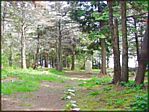 The
Old
Cemetery - This old
community cemetery is a place of extraordinary beauty. The
trees here are extremely old and typical of the "old growth
forest" that once covered the island. No one would dare
cut down a tree in this sacred place. With so little old
forest remaining in Newfoundland, there is a great concern that
some of it be preserved for posterity from the greedy maws of the
paper maker's harvesting machines. The
Old
Cemetery - This old
community cemetery is a place of extraordinary beauty. The
trees here are extremely old and typical of the "old growth
forest" that once covered the island. No one would dare
cut down a tree in this sacred place. With so little old
forest remaining in Newfoundland, there is a great concern that
some of it be preserved for posterity from the greedy maws of the
paper maker's harvesting machines.
|
|
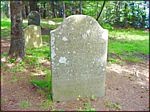 Edward Cooper's
Resting Place - Behold dear friends as you pass by, Behold
the place where I do lie, I hope the Lord will all you bless, And
pray to God to grant me rest. Edward Cooper's
Resting Place - Behold dear friends as you pass by, Behold
the place where I do lie, I hope the Lord will all you bless, And
pray to God to grant me rest.
|
|
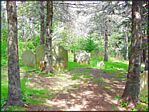 Tranquility
Personified - Here they lie, proud Newfoundland pioneers,
reminding us of our heritage and of the stock from which we have
sprung. ..."So farewell friends and acquaintance all,
Pas by this tomb in friendship call, Look on the same without
grief or fear, Tis my choice to be buried here. Tranquility
Personified - Here they lie, proud Newfoundland pioneers,
reminding us of our heritage and of the stock from which we have
sprung. ..."So farewell friends and acquaintance all,
Pas by this tomb in friendship call, Look on the same without
grief or fear, Tis my choice to be buried here.
|
|
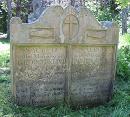 Kent
Brothers - This stone erected to the memory of the Kent brothers,
George and James, is by far the most elaborate of the stones in the old pioneer cemetery.
Being, like the others, made from relatively fragile sandstone, it is remarkable how well it has survived the elements.
Please see the epitaphs elsewhere in this site. Kent
Brothers - This stone erected to the memory of the Kent brothers,
George and James, is by far the most elaborate of the stones in the old pioneer cemetery.
Being, like the others, made from relatively fragile sandstone, it is remarkable how well it has survived the elements.
Please see the epitaphs elsewhere in this site.
|
|
 The
Broken Stone - The headstone of James Pitts as it lay on the ground, smashed to pieces by an act of vandalism that occurred sometime between the summer of 1969, and June 1988 when this photograph was taken. To compound this shameful act of destruction, the stone fragments were subsequently thrown over the adjacent cliff side from which sufficient have been retrieved to confirm the dastardly deed. Fortunately, the epitaph had been previously transcribed and preserved. Because of the special historical significance of this stone, a fund has been set up to replace it with a
replica, hopefully in time for the 200th anniversary of Mr. Pitts's passing, April 30, 1805. Those wishing to contribute to this fund please contact the author of this web site for details. Any relative comments can be submitted to the guest book. The estimated cost of replacing the stone is c. $2000, so, with many contributing a small amount, it shouldn't be too difficult to raise this sum. The
Broken Stone - The headstone of James Pitts as it lay on the ground, smashed to pieces by an act of vandalism that occurred sometime between the summer of 1969, and June 1988 when this photograph was taken. To compound this shameful act of destruction, the stone fragments were subsequently thrown over the adjacent cliff side from which sufficient have been retrieved to confirm the dastardly deed. Fortunately, the epitaph had been previously transcribed and preserved. Because of the special historical significance of this stone, a fund has been set up to replace it with a
replica, hopefully in time for the 200th anniversary of Mr. Pitts's passing, April 30, 1805. Those wishing to contribute to this fund please contact the author of this web site for details. Any relative comments can be submitted to the guest book. The estimated cost of replacing the stone is c. $2000, so, with many contributing a small amount, it shouldn't be too difficult to raise this sum.
|
|
 Lance Cove Today
- Same viewpoint but a much different scene than that of 1900. Lance Cove Today
- Same viewpoint but a much different scene than that of 1900.
|
|
 A
New Beginning? - "The old order changeth, giving place
to new......", but there are some things that never change. A
New Beginning? - "The old order changeth, giving place
to new......", but there are some things that never change.
|
 
|